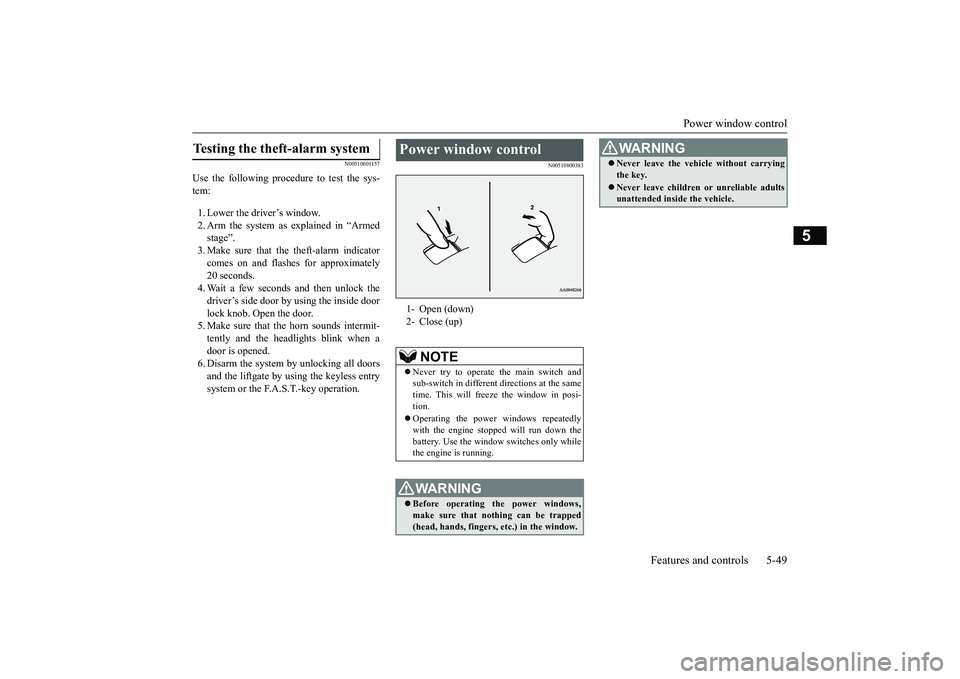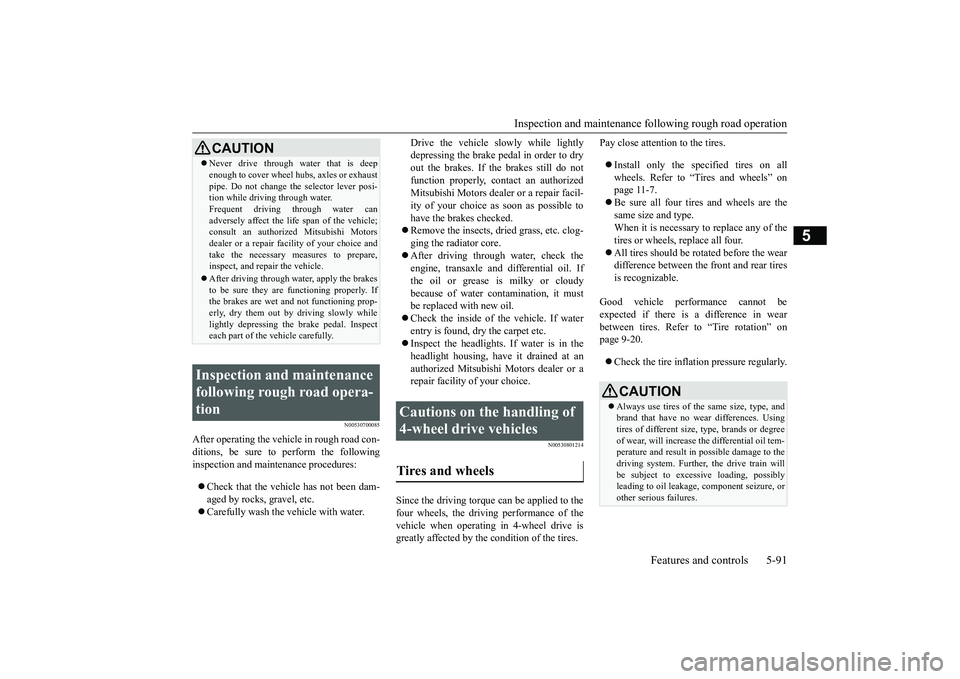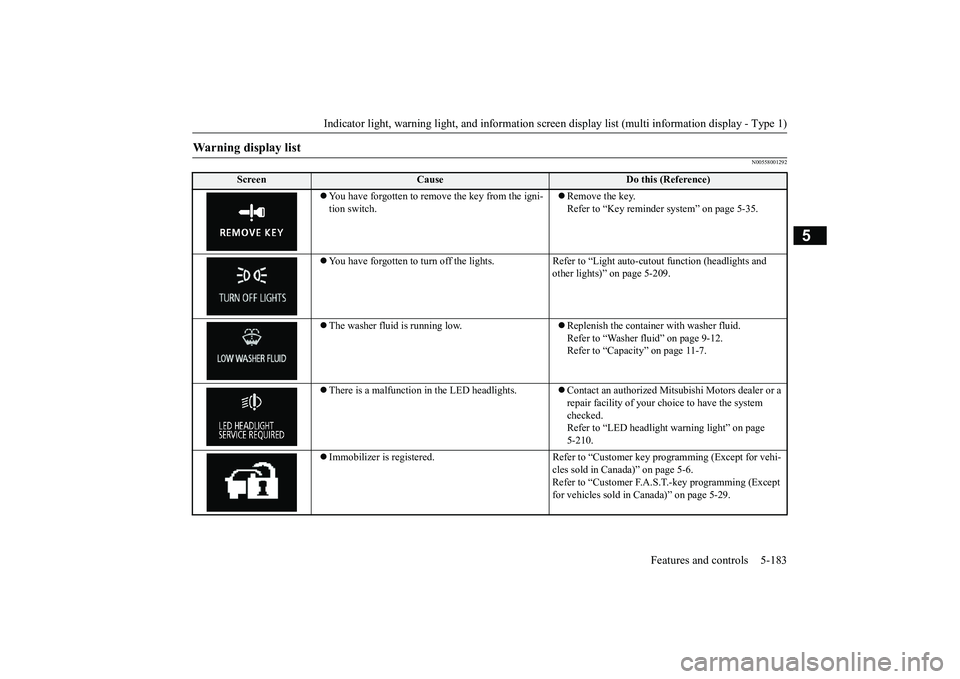2018 MITSUBISHI OUTLANDER III headlights
[x] Cancel search: headlightsPage 130 of 441

Power window control
Features and controls 5-49
5
N00510601157
Use the following procedure to test the sys-tem:1. Lower the driver’s window.2. Arm the system as explained in “Armedstage”.comes on and flashe
s for approximately
20 seconds.4. Wait a few seconds and then unlock thedriver’s side door by using the inside doorlock knob. Open the door.5. Make sure that the horn sounds intermit-tently and the headlights blink when adoor is opened.6. Disarm the system by unlocking all doorsand the liftgate by using the keyless entrysystem or the F.A.S.T.-key operation.
N00510800383
Testing the theft-alarm system
Power window control 1- Open (down)2- Close (up)
NOTE
Never try to operate the main switch andsub-switch in different
directions at the same
time. This will free
ze the window in posi-
tion.Operating the power windows repeatedlywith the engine stoppe
d will run down the
battery. Use the window
switches only while
the engine is running.WA R N I N GBefore operating the power windows,make sure that nothing can be trapped(head, hands, fingers, etc.) in the window.
Never leave the vehicle without carryingthe key.Never leave children
or unreliable adults
unattended inside the vehicle.WA R N I N G
BK0249100US.book 49 ページ 2017年5月10日 水曜日 午前8時49分
Page 140 of 441

Inside rearview mirror
Features and controls 5-59
5
The day/night knob (A) at
the bottom of the
mirror can be used to adjust the mirror toreduce the glare from the headlights of vehi-cles behind you during night driving.
When the headlights of the vehicles behindyou are very bright, the reflection factor ofthe rearview mirror is automatically changedto reduce the glare.Normally, use the automatic mode. When theignition switch is turned to the “ON” positionor the operation mode is put in ON, thereflection factor of the mirror is automaticallychanged.
To reduce the glare Ty p e 1 1- Daytime position2- Night position
Ty p e 2
NOTE
Do not hang items on,
or spray glass cleaner
on the sensor (1), as reduced sensitivitycould result.
BK0249100US.book 59 ページ 2017年5月17日 水曜日 午後2時31分
Page 141 of 441

Outside rearview mirrors5-60 Features and controls
5
When the headlights of the vehicles behindyou are very bright, the reflection factor ofthe rearview mirror is automatically changedto reduce the glare.Normally, use the automatic mode. When theignition switch is turned to the “ON” positionor the operation mode is put in ON, the greenindicator (1) illuminates and the reflectionfactor of the mirror is automatically changed.
N00512201232
Adjust the outside rearview mirrors only aftermaking any seat adjustme
nts so as to have a
clear view to the rear of the vehicle.
Ty p e 3
NOTE
Do not hang items on,
or spray glass cleaner
on the sensor (2), as
reduced sensitivity
could result.If you want to stop automatic mode, pressthe switch (3) and the indicator will go off.To return to automatic mode, press theswitch again or perfor
m the following opera-
tion.[Except for vehicles e
quipped with the Free-
hand Advanced Secu
rity Transmitter
(F.A.S.T.-key)]Turn the ignition switch to the “ON” positionafter turning to “OFF” or “ACC” position.[For vehicles equipped with the Free-handAdvanced Security Transmitter (F.A.S.T.-key)]Put the operation mode
in ON after putting
the operation mode in OFF.
Outside rearview mirrors
WA R N I N GDo not attempt to adjust the outside rear-view mirrors while driving. This can bedangerous.Be sure to adjust the mirrors before driv-ing.
BK0249100US.book 60 ページ 2017年5月17日 水曜日 午後2時31分
Page 172 of 441

Inspection and maintenance following rough road operation
Features and controls 5-91
5
N00530700085
After operating the vehicle in rough road con-ditions, be sure to perform the followinginspection and maintenance procedures:Check that the vehicle has not been dam-aged by rocks, gravel, etc.Carefully wash the
vehicle with water.
Drive the vehicle slowly while lightlydepressing the brake pedal in order to dryout the brakes. If the brakes still do notfunction properly, contact an authorizedMitsubishi Motors dealer or a repair facil-ity of your choice as
soon as possible to
have the brakes checked.Remove the inse
cts, dried grass, etc. clog-
ging the radiator core.After driving through water, check theengine, transaxle and
differential oil. If
the oil or grease is milky or cloudybecause of water c
ontamination, it must
be replaced with new oil.Check the inside of the vehicle. If waterentry is found, dry the carpet etc.Inspect the headlights. If water is in theheadlight housing, have
it drained at an
authorized Mitsubishi
Motors dealer or a
repair facility of your choice.
N00530801214
Since the driving torque can be applied to thefour wheels, the driving performance of thevehicle when operating in 4-wheel drive isgreatly affected by the condition of the tires.
Pay close attention to the tires.Install only the specified tires on allwheels. Refer to “Tires and wheels” onpage 11-7.Be sure all four tire
s and wheels are the
same size
and type.
When it is necessary to replace any of thetires or wheels, replace all four.All tires should be rotated before the weardifference between the
front and rear tires
is recognizable.
Good vehicle performance cannot beexpected if there is a difference in wearbetween tires. Refer to “Tire rotation” onpage 9-20.Check the tire inflati
on pressure regularly.
CAUTIONNever drive through water that is deepenough to cover wheel hubs, axles or exhaustpipe. Do not change th
e selector lever posi-
tion while driving through water.Frequent driving through water canadversely affect the life
span of the vehicle;
consult an authorized Mitsubishi Motorsdealer or a repair faci
lity of your choice and
take the necessary measures to prepare,inspect, and repair the vehicle.After driving through wa
ter, apply the brakes
to be sure they are functioning properly. Ifthe brakes are wet and not functioning prop-erly, dry them out by
driving slowly while
lightly depressing the
brake pedal. Inspect
each part of the vehicle carefully.
Inspection and maintenance following rough road opera-tion
Cautions on the handling of 4-wheel drive vehicles Tires and wheels
CAUTIONAlways use tires of th
e same size, type, and
brand that have no wear differences. Usingtires of different size,
type, brands or degree
of wear, will increase the differential oil tem-perature and result in
possible damage to the
driving system. Further, the drive train willbe subject to excessi
ve loading, possibly
leading to oil leakage, component seizure, orother serious failures.
BK0249100US.book 91 ページ 2017年5月10日 水曜日 午前8時49分
Page 180 of 441

Electric power steering system (EPS)
Features and controls 5-99
5
The anti-lock braking system and brake forcedistribution function ma
y not work, so hard
braking could make the vehicle unstable.Avoid hard braking and high-speed driving.Stop the vehicle in a safe place and contact anauthorized Mitsubishi Mo
tors dealer or repair
facility of your choice.
N00529201090
After driving on snow or icy roads, removeany snow and ice which may have be leftaround the wheels. On vehicles that have ananti-lock braking syst
em, be careful not to
damage the wheel spee
d sensors (A) or the
cables located at each wheel.
N00568401084
The power steering system operates while theengine is running. It helps reduce the effortneeded to turn the steering wheel.The power steering sy
stem has mechanical
steering capability in case the power assist islost. If the power assist is lost for some rea-son, you will still be able to steer your vehi-cle, but you will notice it takes much moreeffort to steer. If this happens, have your vehi-cle inspected at an authorized MitsubishiMotors dealer or a repair facility of yourchoice.
Warning lamp
NOTE
The anti-lock braking
system warning light
and brake warning light illuminate at thesame time and the wa
rning displays appear
alternately on the information screen in themulti-information display.
After driving on icy roads
Electric power steering sys-tem (EPS) Front Rear
WA R N I N GDo not stop the engine while the vehicle ismoving. Stopping the engine would makethe steering wheel extremely hard to turn,possibly resulting
in an accident.
NOTE
During repeated full-lock turning of thesteering wheel (for example, while you aremanoeuvring the vehicle into a parkingspace), a protection f
unction may be acti-
vated to prevent overheating of the powersteering system. This f
unction will make the
steering wheel graduall
y harder to turn. In
this event, limit your turning of the steeringwheel for a while. When the system hascooled down, the steering effort will returnto normal.If you turn the steering wheel while the vehi-cle is stationary with the headlights on, theheadlights may become
dim. This behavior
is not abnormal. The he
adlights will return to
their original brightness after a short while.
Electric power steering system warning display
BK0249100US.book 99 ページ 2017年5月10日 水曜日 午前8時49分
Page 217 of 441

Lane Departure Warning System (LDW) (if so equipped)5-136 Features and controls
5
N00578100045
If a problem occurs with the system, a visualwarning specific to the type of the problem isgiven together with an audible alarm.The alarm shown below is displayed if thesystem becomes temporarily unavailable dueto the high or low temperature of the sensor.After temperature of the sensor has been inrange, the system will automatically return tooperation.If the alarm continues s
howing, there is a pos-
sibility that the LDW
has a malfunction. Con-
tact an authorized Mitsubishi Motors dealerfor inspection of the system.
NOTE
The warnings will not continue for more than3 seconds, even if your vehicle continuesleaving the lane.If the lane markers are only on one side ofthe road, the LDW will operate only for theappropriate side where the lane marker isdrawn.WA R N I N GThe LDW will not function when no lanemarker exists, such as at an intersectionor near a toll booth.The LDW may not operat
e correctly in the
following situations and the LDW may notgive warnings or may
give false warnings:
• When lane markers are not clearly visi-ble due to rain, snow, fog, dark area, etc.• When the road surface is shiny.• When old lane markers remain on theroad surface.• When the lane markers are double linesor the shape of the lane markers arecomplicated.• When driving in an extremely narrowlane.• When the distance between your vehicleand a vehicle in
front is short.
• When driving into the sun light.• When driving on curves.• When driving on bumpy roads.• When driving in construction zones.
• When passing through a place where thebrightness suddenly changes, such as atthe entrance to or exit of a tunnel.• When the headlights of an oncomingvehicle are very bright. • When the rear of your vehicle is weigheddown with the weight of passengers andluggage.• When the headlights
of your vehicle are
not clean or are not properly aimed.• When the front windshield is not clean.• When the front windshield wipers do notclean the windshield properly.CAUTIONTo maintain proper function of the LDW:• Always keep the windshield and the head-lights clean.• Do not put anything, such as a sticker, onthe front windshield in front of the sensor.• Avoid applying a shock or load to the sen-sor.• Do not attempt to deta
ch or disassemble the
sensor.• Use only Mitsubishi Mo
tors Genuine parts
when replacing the
windshield wipers.
NOTE
When driving conditions are not suitable touse the LDW, turn off the LDW.WA R N I N G
System problem warning
Sensor is too hot or cold
BK0249100US.book 136 ページ 2017年5月10日 水曜日 午前8時49分
Page 264 of 441

Indicator light, warning light, and information screen display list (multi information display - Type 1)
Features and controls 5-183
5
N00558001292
Warning display list
Screen
Cause
Do this (Reference)
ove the key from the igni-
tion switch.
Remove the key.Refer to “Key reminder system” on page 5-35.
You have forgotten to turn off
the lights. Refer to “Light auto
-cutout function (headlights and
other lights)” on page 5-209.
The washer fluid is running low.
Replenish the container with washer fluid.Refer to “Washer fluid” on page 9-12.Refer to “Capacity” on page 11-7.
There is a malfunction
in the LED headlights.
Contact an authorized Mitsubishi Motors dealer or a repair facility of your choi
ce to have the system
checked.Refer to “LED headlight
warning light” on page
5-210.
Immobilizer is registered. Refer to “Cus
tomer key programming (Except for vehi-
cles sold in Canada)” on page 5-6.Refer to “Customer F.A.S.
T.-key programming (Except
for vehicles sold in Canada)” on page 5-29.
BK0249100US.book 183 ページ 2017年5月10日 水曜日 午前8時49分
Page 283 of 441

Indicators5-202 Features and controls
5
N00519900127N00520000216
The arrows will flash in time with the corre-sponding exterior turn signals when the turnsignal lever is used.Both arrows will flash
when the hazard warn-
ing flasher swit
ch is pressed.
N00520100086
A blue light comes on when the headlightsare on high beam.
N00520200175
This indicator comes on while the front foglights are on.
N00551301078
This indicator light illuminates while theparking lights are on.
N00575601020
This indicator comes on in blue while thecoolant temperature is low.
N00579200030
This function displays
how fuel-efficiently
you are driving under different driving condi-tions.The ECO drive assist di
splay will change as
follows if you do fuel-efficient driving usingthe accelerator in a way well matched withthe vehicle speed.
24- Engine malfuncti
on indicator (“SER-
VICE ENGINE SOON” or “Checkengine light”)
P. 5-204
25- Seat belt remi
nder/warning light
P. 4-23
26- Tire pressure moni
toring system warn-
ing light
P. 5-138
27- Brake warning light (red)
P. 5-203
28- Multi information display
P. 5-173
Indicators Turn signal indicators/Hazard warning lights
NOTE
If the indicator flashes faster than usual or ifthe indicator stays on wi
thout flashing, check
for a malfunctioning turn signal light bulb orturn signal connection.
High beam indicator Front fog light indicator
(if so
equipped)Position indicator Low coolant temperature indi-cator - blue (Vehicle equipped with the multi information dis-play - Type 2)
NOTE
When the indicator go
es out, this should be
used as a rough indication of when the heat-ing starts working.
ECO Drive Assist (Vehicle equipped with the multi infor-mation display - Type 2)
ECO drive levelLow High
BK0249100US.book 202 ページ 2017年5月10日 水曜日 午前8時49分